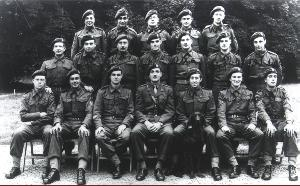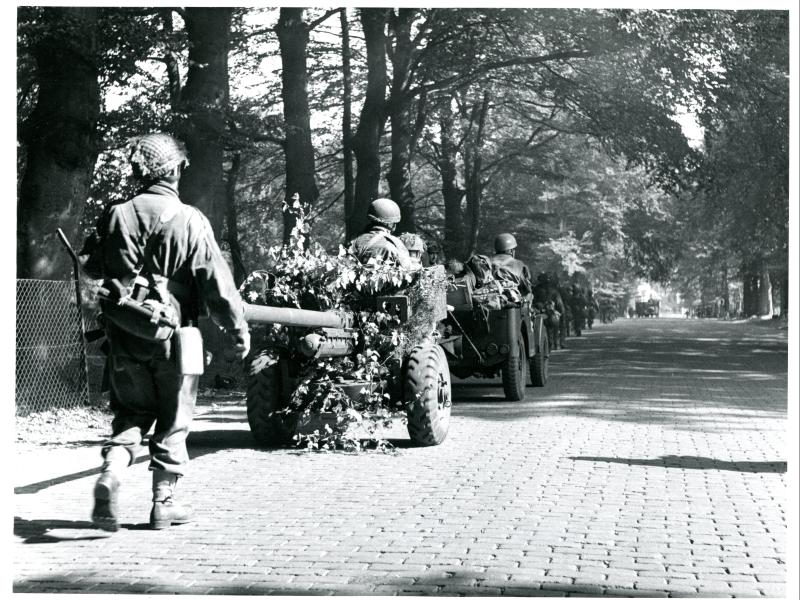Airborne Spies: 89 Field Security Section, Intelligence Corps
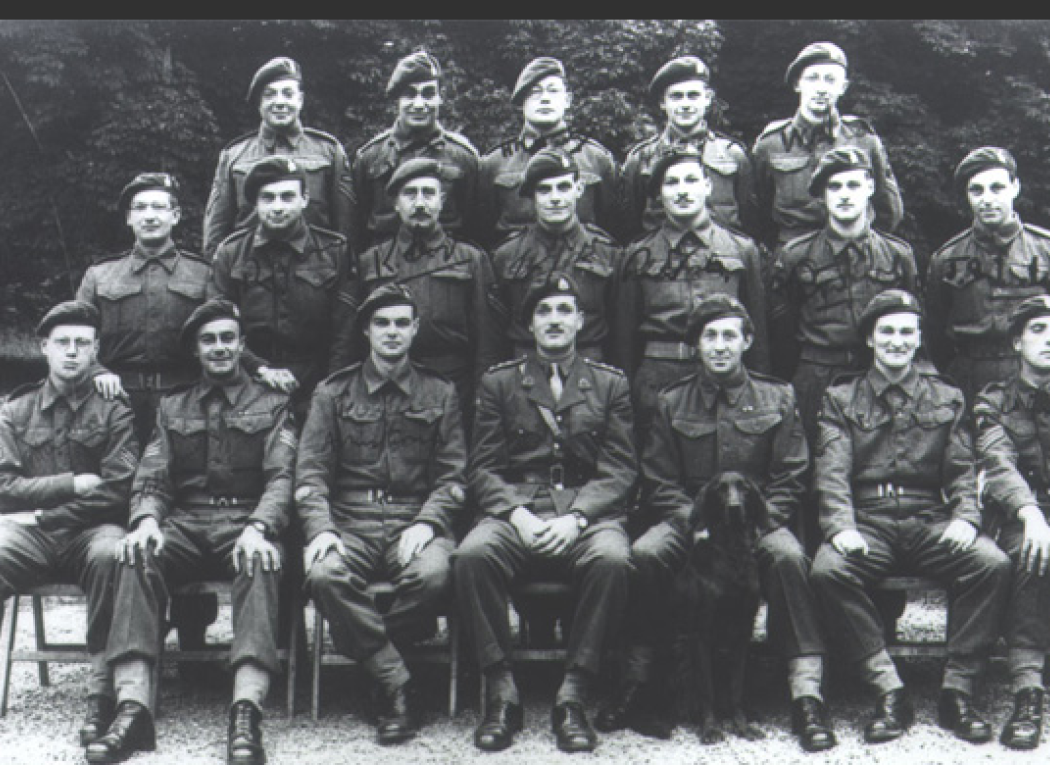
Back Row, L-R: Cpls D Zucker, E Zitman, M Hanet, A Maybury and PD Scarr.
Middle Row, L-R: Cpls MN Edwards, R Gray, R Smyth, AJ Gorrie, R Foster, B Gately and J Linden.
Front Row, L-R: Sgts T Chambers and A Ramage, WO2 T Armstrong, Capt. JE Killick, L/Cpl F Eley, Sgts R Syme and R Pinquet. (Airborne Assault Museum)
What is 'Field Security'?
A Field Security Section, an Army Divisional intelligence capability, was a 20-man section, all members of the Intelligence Corps. It was one of the smallest elements in a Division.
The concept of Field Security (FS) predates the formation of the Intelligence Corps (July 1940) by some years. Indeed, it could be suggested that it is a Napoleonic device, with Wellington’s Army of the Peninsula having a capability not dissimilar. This concept of operations was certainly employed in the Boer Wars and on various fronts during the Great War.
From the Great War’s ‘Scouts’, the FS role devolved to the Corps of Military Police and, in the late 1930s, saw the establishment of the Field Security Police. The role was then transferred to the Intelligence Corps when it was formed in 1940.
In barracks before deploying, a Field Security Section (FSS) would find itself conducting standard ‘security’ tasks, from documentary to physical – checking on the classified papers and making sure the windows and doors were locked.
Once deployed, however, the role of the Section became an intelligence gathering and reporting capability. This intelligence gathering could involve the exploitation (translation and analysis) of captured enemy material, interrogation of prisoners of war (PoW) and the rapid production of intelligence reports for commanders. Additionally, should the Section be operating from a static base for a prolonged period of time, it could engage in the establishment and management of local intelligence assets (agents), which is a counter-intelligence role.
Who were Field Security Soldiers?
Field Security (FS) personnel were selected from volunteers and those nominated by commanding officers, and some may have been poached by the Intelligence Corps. FS personnel were ‘soldiers first’, and FS operatives afterwards. Perhaps looking to their Military Police heritage – where all trained soldiers are Non-Commissioned Officers (NCOs) - all FS soldiers were also NCOs. The primary skills of FS soldiers were an aptitude for languages (to allow the translation of enemy materials and interrogation of PoWs, as well as the management of agents in the field), a capacity for independent operation (as direction could be limited in the field) and a clear capability to assess the importance of material for reporting. Reporting was through the Intelligence Staff Officers in the Divisional HQ.
These capabilities were even more important for Airborne Soldiers, who - as volunteers for parachuting - would find themselves immediately behind enemy lines. The first parachute FS Section was 89 FSS in the 1st Airborne Division. This FSS number was not simply a random number allocated to confuse the enemy: the Intelligence Corps had many FSS across the Army, and 88 FSS and 90 FSS existed in other Divisions.
89 Field Security Section
89 FSS was formed in the summer of 1942, as the FSS for 1st Airborne Division, with Captain Jack Dunbar in command as the Field Security Officer (FSO). Having spent some time in the Wiltshire area, 89 FSS deployed to North Africa with the fledgling 1st Airborne Division as part of Operation TORCH in November 1942.
Captain Dunbar was tragically killed when his glider ditched in the Mediterranean during Operation HUSKY - the invasion of Sicily invasion - in July 1943. He was a strong swimmer but was drowned as he went to the assistance of another soldier; he is commemorated on the Memorial in the Commonwealth War Graves Commission Cemetery at Cassino, Italy.
Command of the Section fell to the Company Sergeant Major, John ‘Jack’ Loker, who led the Section throughout the Division’s nine-month Italian Campaign and was commissioned on return to the UK in 1944. He appears in photographs of the Section in Wellingore, Lincolnshire, but left the Section when Captain John Killick, the new FSO, arrived.
89 Field Security Section in Lincolnshire
89 FSS arrived in Lincolnshire from North Africa in early 1944. It was sub-divided and attached to the Divisional and Brigade HQs, and it had a variety of bases in Lincolnshire, including Leadenham High House, the Gregory Arms Inn at Harlaxton and Hill House, Wellingore. The Section seems to have spent a lot of its off-duty hours in Wellingore at the Red Lion Inn, which fronted the High St and backed onto the Grantham road (A607). As of 2025, it was still an inn. The following photographs show the Section in a field at Wellingore, with many of the Section identifiable.
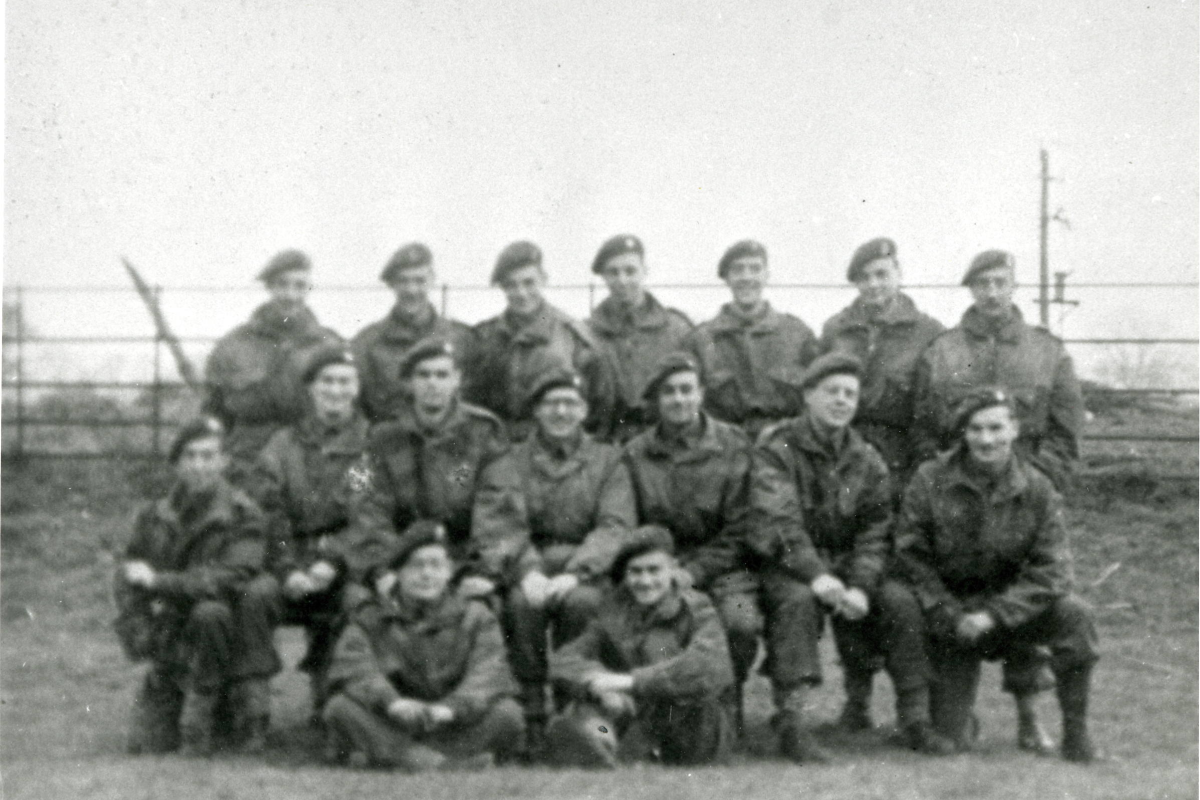
89 FSS in Wellingore, Lincolnshire in early 1944. (Airborne Assault Museum)
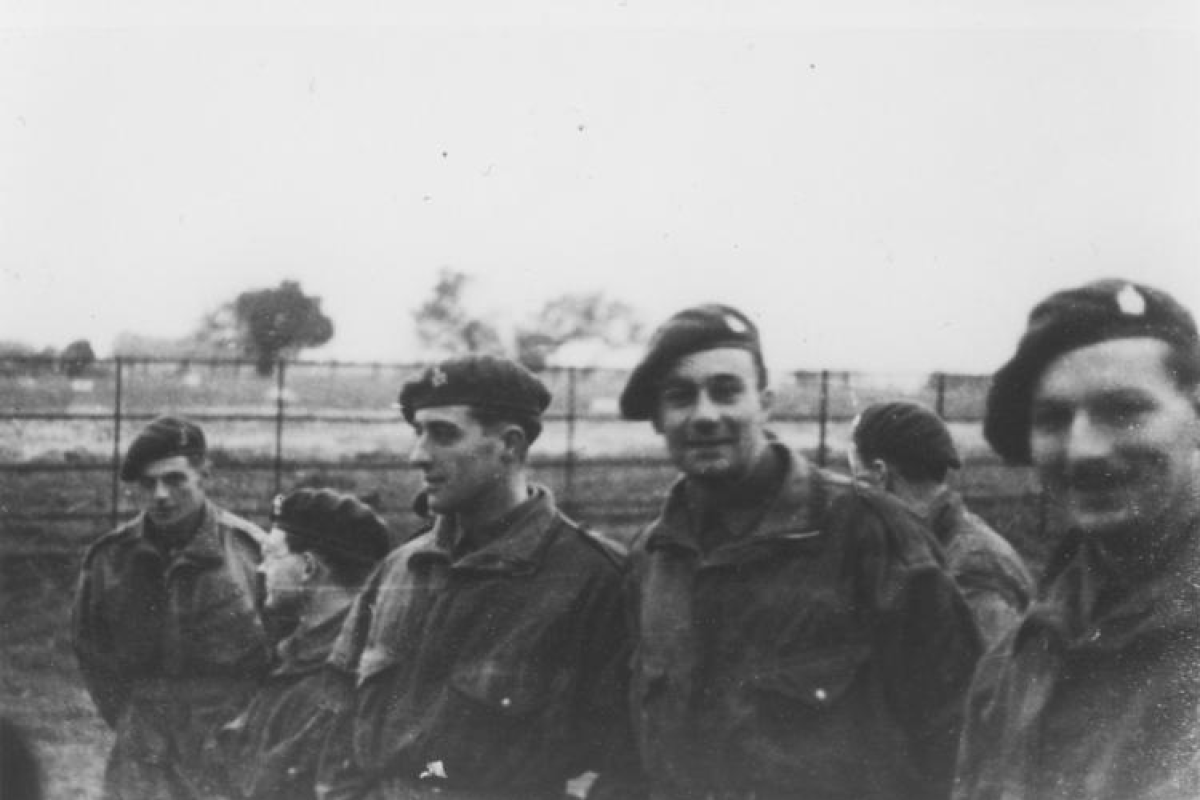
89 FSS in Wellingore, with CSM Jack Loker and Sgt Bob Pinguet to the centre. (Airborne Assault Museum)
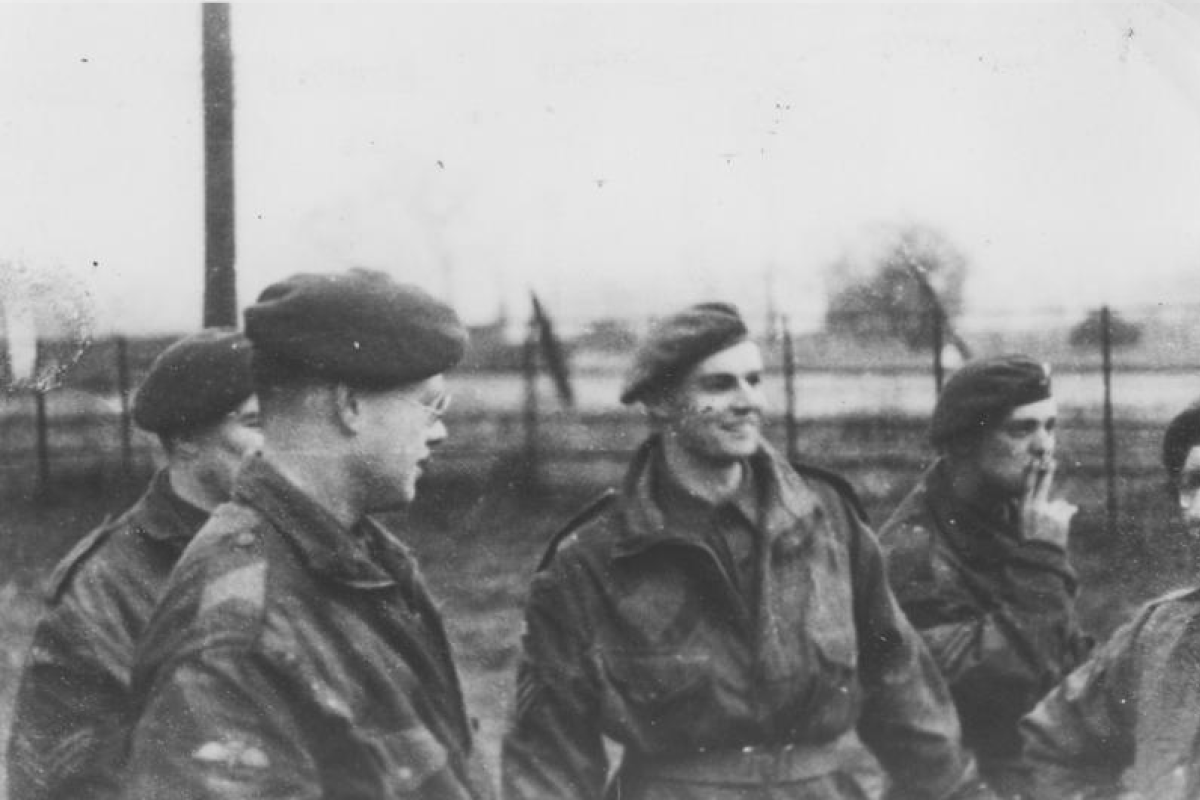
89 FSS in Wellingore, with Terry Chambers and Terry Armstrong in centre. (Airborne Assault Museum)
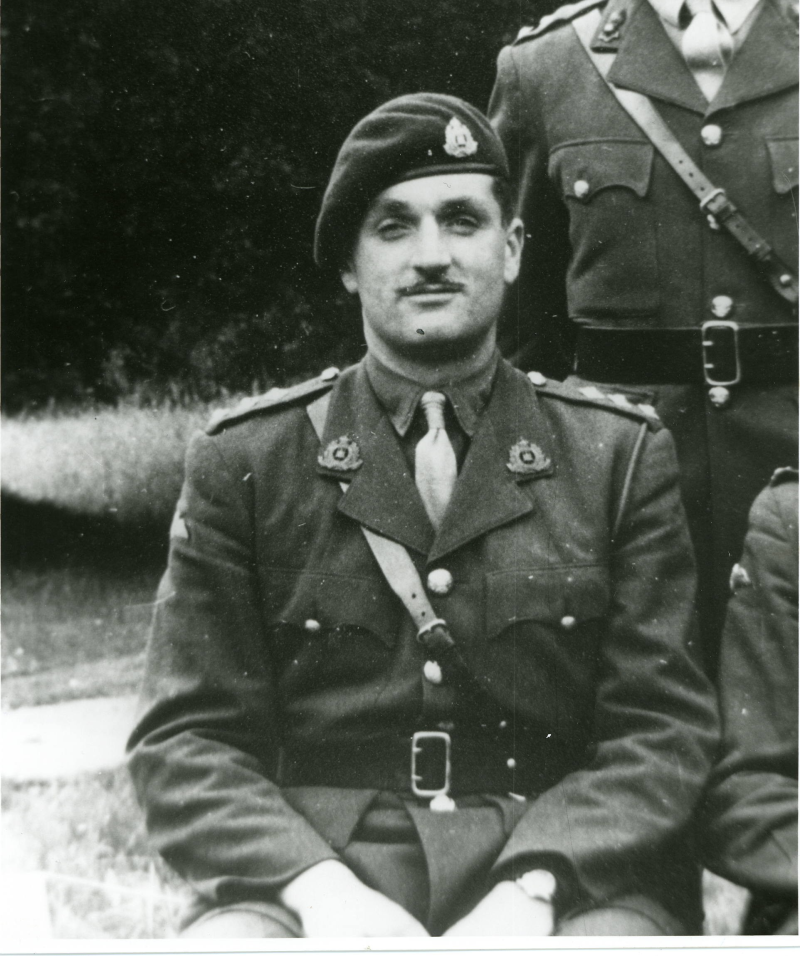
Captain John Killick, Field Security Officer, 89 Field Security Section. (Airborne Assault Museum)
Captain John Killick took command as the FSO in late spring 1944. He had previously served with 317 FSS in the 6th Airborne Division and had taken part with 317 FSS in Exercise MUSH in April 1944. Although he was an Intelligence Corps officer, he continued to wear the cap badge of the Suffolk Regiment, the Regiment into which he had been commissioned after war broke out and from which he had been attached to the Intelligence Corps.
While in Lincolnshire, some members of 89 FSS were posted to 317 FSS - the 89 FSS counterpart in the 6th Airborne Division - to strengthen it with experienced troops. Company Sergeant Major (CSM) Jack Loker departed on commissioning and was replaced by CSM Terry Armstrong.
From June 1944, the Section had a number of ‘alarums and excursions’ with the FSO recalling that they were issued armbands and francs for possible operations in France but they were all cancelled. Finally, Operation MARKET GARDEN was given the go-ahead.
Operation MARKET GARDEN
The men of 89 FSS began deploying to Arnhem on 17 September 1944. Their first tasks were to round up known Dutch Nazi sympathisers and to interrogate German PoWs, but the battle developed so rapidly and unexpectedly that the Section members fought largely as infantry: they were soldiers first.
By the end of the battle, 89 FSS had been destroyed: only four members escaped captivity, and one of those (Corporal Scarr) died of wounds on 27 September 1944.
89 FSS deployed 16 men to Arnhem by parachute and glider, with a further three men in Belgium attached to the 1st Airborne Division's Seaborne Echelon. The following table summarizes the deployment:
17 September 1944 - First Parachute Drop
| Name | Attached | Notes |
|---|---|---|
| Captain Killick | Division HQ | Prisoner of War, captured 21 Sep 44, Arnhem road bridge |
| Sergeant Chambers | Division HQ | Prisoner of War, captured 21 Sep 44, Arnhem road bridge |
| Sergeant Pinguet | 1st Parachute Brigade HQ | Wounded 17 Sep 44, Prisoner of War |
| Corporal Gately | 1st Parachute Brigade HQ | Prisoner of War |
| Corporal Gray | 1st Parachute Brigade HQ | Prisoner of War |
| Corporal Linden | 1st Parachute Brigade HQ | Prisoner of War |
| Corporal Maybury (Killed in Action, 17 Sept 1944) | 1st Parachute Brigade HQ | Killed in action, 17 Sep 44 |
17 September 1944 - First Glider Lift
| Name | Attached | Notes |
|---|---|---|
| Company Sergeant Major Armstrong | Division HQ | Evaded capture |
| Sergeant Ramage | 1st Air Landing Brigade HQ | Evaded capture |
| Corporal Foster | 1st Air Landing Brigade HQ | Wounded in action, Prisoner of War |
18th September 1944 - Second Parachute Drop
| Name | Attached | Notes |
|---|---|---|
| Corporal Gorrie | 4th Parachute Brigade | Evaded capture |
| Corporal Hanet | 4th Parachute Brigade | Evaded capture |
| Sergeant Syme | 4th Parachute Brigade | Prisoner of War |
| Corporal Zitman | 4th Parachute Brigade | Wounded in action, Prisoner of War |
18th September 1944 - Second Glider Lift
| Name | Notes |
|---|---|
| Corporal Scarr | Evaded capture but died of wounds, 27 Sep 44 |
| Corporal Smyth | Prisoner of War |
1st Airborne Division Seaborne Echelon
Much of an Airborne formation’s equipment could not be delivered by air, and some of its personnel and equipment were not considered vital in the early part of an operation but would take up valuable aircraft space. These elements were referred to as the 'Seaborne Echelon' or 'Seaborne Tail' and would travel by sea and land to meet up with the Airborne formation after it had been relieved by ground forces.
The following members of 89 FSS were part of the 1st Airborne Division Seaborne Echelon and were in Belgium on 17th September 1944:
Corporal Edwards
Corporal Zucker
Lance Corporal Eley
89 FSS BIOGRAPHIES
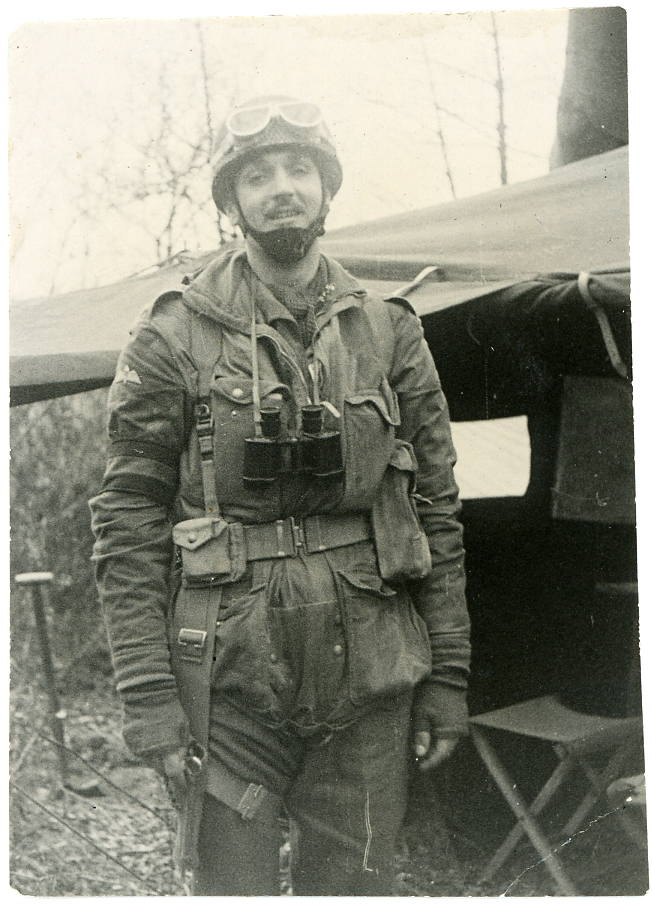
Captain John Killick while serving with 317 FSS on Exercise MUSH in April 1944. (Airborne Assault Museum)
Captain John Killick
John Killick was born in west London in 1919. He was thinking of a career in the Diplomatic Service and studied for a degree in Modern Languages (French & German) at University College London, where he played rugby and was a member of the University Officers Training Corps (OTC). A German speaker, he was in Germany on an exchange at Bonn University in the summer of 1939 and returned to the UK in August 1939 for an OTC Camp.
Killick was commissioned in the Suffolk Regiment and was posted to the Gambia to carry out topographical work for an attack on Dakar, having at his disposal maps that were several decades old. The attack was called off, and he returned to the UK with a potential fiancée – a South African Airforce pilot! She became the first Lady Killick when Sir John was knighted post-war. Technically an Intelligence Corps officer at this point, Killick neglected to purchase the Corps’ badges & buttons, retaining his Suffolk Regiment cap badge even at the Bridge.
Killick accompanied the 2nd Battalion to the Arnhem road bridge, where he remained with the 1st Parachute Brigade HQ in its defence. As the defence of the Bridge collapsed, he attempted to evade but was captured on 21 September in the inspection pit of a garage! He made an unsuccessful bid to escape captivity and the notes he made in captivity are littered with thoughts of escape but predominately of food or lack of it.
After the war, John Killick went on to have an extremely successful career in the Diplomatic Service, with appointments as HM Ambassador to Moscow and then to NATO at the height of the Cold War. He was knighted in 1971. He taught himself to play the guitar while in a German PoW camp and his prowess on it was a feature of many Embassy functions. Sir Johnn Killick died in 2004, almost 60 years to the day after he assumed command of 89 FSS. A road has been named in his honour on the site of Templer Barracks in Ashford, the former Depot of the Intelligence Corps.
John Killick wrote down his memories of the action at Arnhem while he was held in German captivity. A copy of them is held in the archives at Harlaxton Manor and a pdf version can be viewed by clicking here: 'Arnhem to Brunswick' - Memories of Captain Killick.
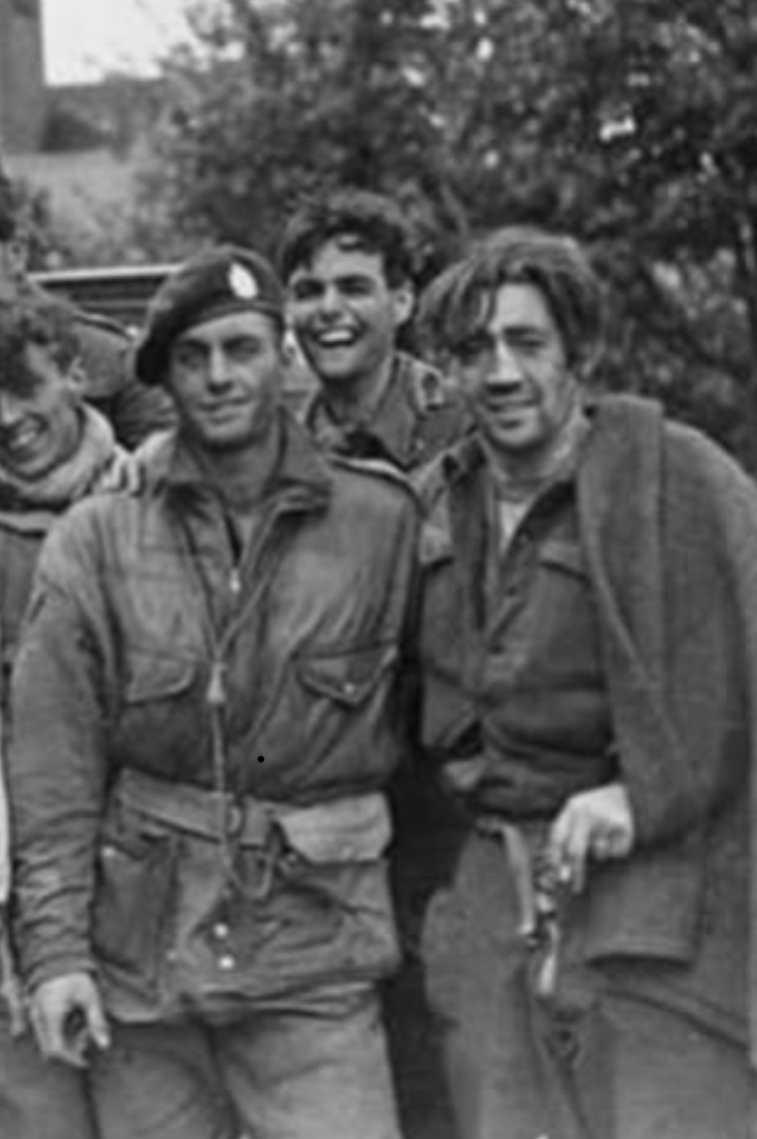
CSM Terry Armstrong (centre rear) after crossing the Rhine to safety on 25 September 1944. His joy at surviving is obvious! (Airborne Assault Museum)
Company Sergeant Major Terry Armstrong
Terry Armstrong was born in Surrey in 1920, and graduated with a first-class honours degree in French and Russian from Magdalene College, Cambridge, in 1940. He joined the newly formed Intelligence Corps directly and was an early volunteer for parachuting duties. Armstrong joining 89 FSS in time to serve with the 1st Airborne Division in North Africa, Sicily and on the Italian mainland before returning to the UK. With the departure of Jack Loker on commissioning, Terry was promoted to Company Sergeant Major before Operation MARKET GARDEN. Deployed by glider, Terry stayed with Divisional Headquarters in Oosterbeek, coordinating the Section’s effort and eventual defence of the Divisional Headquarters at the Hartenstein Hotel. He was one of those who successfully crossed the Neder Rijn river on 25 September 1944, when the perimeter around the Headquarters at the Hartenstein Hotel was abandoned. Terry rejoined the Section (initially under Captain Hodgson – GSO 3 Int at Arnhem and then under Captain Williams, who had been an NCO with the Section in Italy) when the Section deployed with the 1st Airborne Division on Operation DOOMSDAY, liberation duties to Norway, in May 1945.
After the war, Terry Armstrong returned to academia, where his fluent Russian and interest in colder climes saw a move into Polar studies. He became a Professor with a post in Canada and easy access to the Arctic. He produced many well-respected geo-political papers and was awarded the Queen’s Polar Medal in recognition of his achievements, and the Armstrong Reef in Antarctica was named in his honour. Terry Armstrong passed away peacefully in 1996.
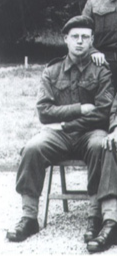
Sergeant Terry Chambers in 1944. (Airborne Assault Museum)
Sergeant Terry Chambers
Terry Chambers had joined the Royal Army Service Corps in 1939 but eventually decided that he wanted to do more in the Army (and gain an extra Shilling a day), so he volunteered for parachute duties and transferred to the Intelligence Corps almost simultaneously. He initially served with 317 FSS in 6th Airborne Division but transferred to 89 FSS on the latter’s return from Italy.
Chambers accompanied Captain Killick to the road bridge at Arnhem, where he was described as having a charmed life during the fighting. He directed artillery fire onto the German positions because ‘somebody had to’. He was reported missing, presumed captured on 25 September 1944, but he had actually been captured along with Captain Killick on 21 September. He was held first in Stalag VIII PoW camp but reportedly escaped and joined a Russian partisan unit before being repatriated in June 1945. His Army service continued in India before he was demobilized in July 1946.
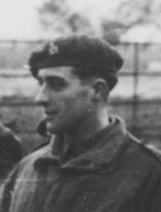
Sergeant Bob Pinguet in 1944. (Airborne Assault Museum)
Sergeant Bob Pinguet
Bob Pinguet was one of the Section’s French speakers. Initially in the non-Airborne 23FSS on conclusion of intelligence training, he joined 89 FSS in North Africa, before operations in Sicily and mainland Italy. His family still have a number of souvenirs of his time in the Mediterranean, including German caps.
In the early evening of 17 September 1944 – the first day of Operation MARKET GARDEN – Sergeant Pinguet made his way along the Utrechtseweg with Corporal Maybury. They captured a Luftwaffe despatch rider. While questioning the prisoner, Sergeant Pinguet’s Sten gun sling became entangled with the motorcycle handlebars. The German took advantage of the situation, drew his pistol and shot Sergeant Pinguet at close range. It was a ‘through-and-through’ wound, with the bullet passing directly through the body and missing all vital organs. Sergeant Pinguet collapsed but managed to crawl into a light well at street level. He was subsequently captured and received medical treatment at Overloon.
Released from captivity on VE-Day, Sergeant Pinguet sought out his former FSO, Captain John Killick, and WO2 Terry Armstrong, petitioning both to rejoin 89 FSS, as he considered he had unfinished business. He did not manage to rejoin 89 FSS but regained his fitness and joined the non-Airborne 316 FSS before he was demobilized.
After the war, Bob Pinguet’s wartime wound did not prevent him from competing in the Men’s Singles at Wimbledon as an amateur in 1948.
Bob Pinguet passed away in 2006.
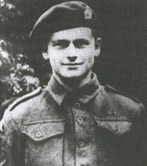
Corporal Arthur Maybury in 1944. (Airborne Assault Museum)
Corporal Arthur Maybury
Arthur Maybury was born in India in 1914 but grew up in Wanstead in East London. He joined the Royal Berkshire Regiment in mid-1940, before transferring to the Royal Signals. He was an early Airborne volunteer (breaking his arm in training in Dec 1941) and served with 1st Airborne Divisional Signals and 2nd Parachute Battalion Signals in North Africa, Sicily and on the Italian mainland. In May 1944, he transferred to the Intelligence Corps and joined 89 FSS.
On 17 September 1944, Arthur Maybury was accompanying Sergeant Bob Pinguet along the Utrechtseweg. It is understood that Corporal Maybury was wounded in the stomach at about the same time as Sergeant Pinguet was wounded. He was recovered by Dutch civilians and treated by a Dr Zwolle, who was subsequently executed by the Germans after they discovered official papers belonging to Corporal Maybury in his possession. Corporal Arthur Maybury died of wounds (officially Killed in Action) on the morning of the 18 September.
However, Corporal Arthur Maybury lives on in two ways. Firstly, Arthur was the author of two collections of Airborne Warfare anecdotes published in 1942-45, under the pseudonym ‘Pegasus’: Thrills with the Paratroops and More Thrills with the Paratroops. Sadly, he was not identified as the author during his lifetime.
Secondly, the site of the former Templer Barracks Depot of the Intelligence Corps in Ashford, Kent, is now a housing estate and one of its roads is named ‘Arthur Maybury Close’.
Corporal Arthur Maybury, aged 30, son of Arthur and Edith Maybury of Wanstead, rests in plot 25A4 of the Oosterbeek Commonwealth War Graves Commission Cemetery to the west of Arnhem. His headstone is inscribed with the words:
All the glorious universe
Is Life.
There is no death
‘Tis but a higher birth
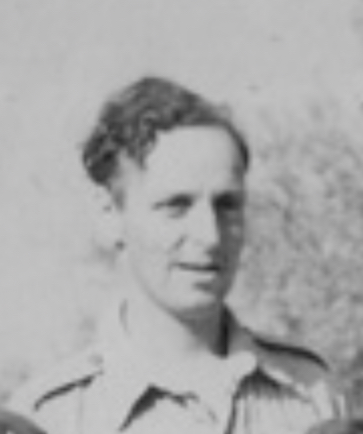
Corporal Jack linden in 1943. (Airborne Assault Museum)
Corporal Jack Linden
Jack Linden had family connections in Henley-upon-Thames and Hampstead in London. He was a pre-war volunteer for the Army, joining the Royal Artillery in April 1939.
Linden transferred to the Intelligence Corps in late 1941, his language skills coming to the fore. He served initially with the non-Airborne 45 FSS. In September 1942, he qualified as a parachutist and transferred to 89 FSS in time to deploy to North Africa, Sicily and the Italian mainland. He returned to the UK with the Section in January 1944.
On 17 September 1944, Corporal Jack Linden flew from Barkston Heath and jumped with the 1st Parachute Brigade during Operation MARKET GARDEN. It is not known whether he made it to the Bridge, but his dates of reported missing/captured suggest he was in Arnhem town at the point of capture. A PoW camp letter dated March 1945 suggests that Corporal Linden had a ‘cheery disposition’ while in captivity, but it is known that he suffered badly in PoW camps in Austria. Jack was one of 89 FSS’s Jewish soldiers and may have disposed of his ID discs and paybook, resulting in harsh treatment by the Germans. He was released from captivity in May 1945 and received an early discharge in March 1946.
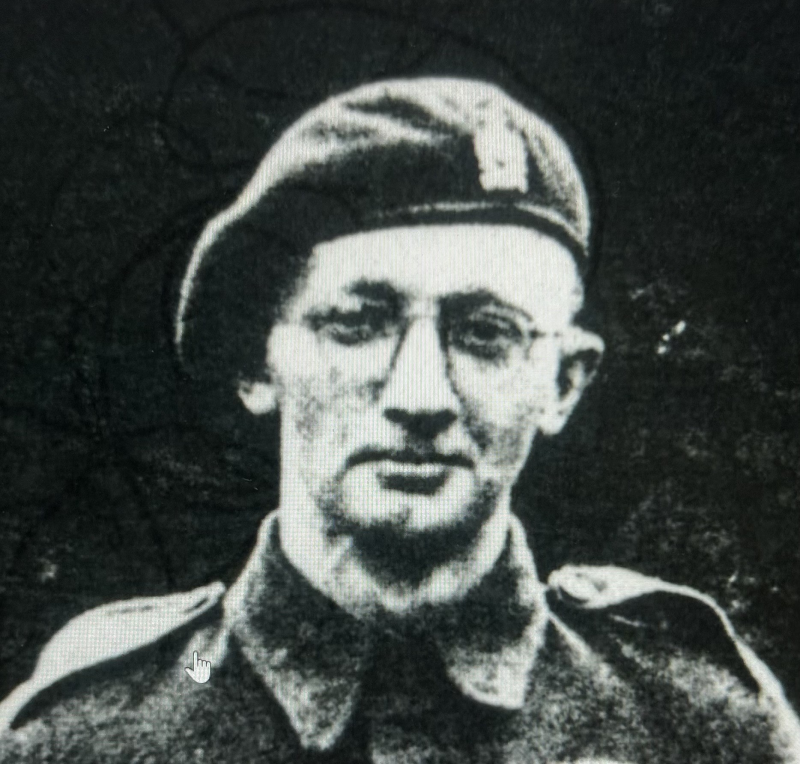
Corporal Philip Scarr in 1944. (Airborne Assault Museum)
Corporal Philip Scarr
Philip Scarr was from Hayes in Kent. Prior to the war, he had been in a Royal Engineers’ unit of the Territorial Army and trained as a searchlight operator, while working for the Ministry of Agriculture. He served in southern England during the Battle of Britain but wanted to do ‘something different’, so transferred to the Intelligence Corps in late 1942. Scarr first joined the non-Airborne 50 FSS and, in 1943/44, moved between a number of non-Airborne Field Security Reserve Detachments that were preparing for the Normandy invasion. He volunteered for parachute training in early 1944 and joined 89 FSS in May 1944.
Corporal Scarr landed near Arnhem on 18 September 1944 as part of the second glider lift. He moved quickly to the Divisional Headquarters in the vicinity of the Hartenstein Hotel. He was wounded in the shoulder by mortar fragments in the grounds of the Hartenstein Hotel on the 20 September. Despite this, he managed to swim part of the way across the Neder Rijn during the Division’s evacuation on 25 September; sadly, he died of wounds and exhaustion later that day in Nijmegen.
Corporal Philip Scarr, aged 24, son of William Scarr and Margaret Scarr, of Hayes, Kent, lies at rest in plot 10E8 of the Commonwealth War Graves Commission Cemetery in Jonkerbos, Nijmegen. His headstone is inscribed with the words:
He loved life,
But justice more.
His bright eager spirit
Exists eternally
Acknowledgement
